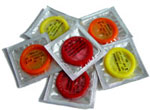Dear Umbra,
I am wondering about the most environmentally safe form of birth control. From what I understand, women’s birth control pills put terrible amounts of hormones into the world’s waters and cause genetic mutations in fish. On the other hand, constantly using and discarding plastic condoms, including the packaging these come in, does not seem like a great solution. Are there more options out there that would cause less harm to my body and the environment?
Thanks,
Adina
Oak Park, Ill.
Dearest Adina,
Safety Pup would like to remind us all that birth control is not the only concern during those delicate moments. One must also close one’s eyes and think of the environment.
Here are the birth-control options of which I am currently aware, broken down by category:
- Hormonal: the Pill, the shot, the implant, the IUD with progesterone (technically known as an IUS, for intra-uterine system), and the new-fangled Ortho Evra, the first transdermal contraceptive patch. All of these release hormones into the body to prevent conception.
- Barrier: condom (male or female), diaphragm, cervical cap. They just get in the way. Of conception, that is.
- Mysterious: intra-uterine device. Scientists aren’t sure exactly why the IUD works, but it does. A small, plastic, copper-releasing device that is inserted by a doctor into the uterus, an IUD typically prevents pregnancy by keeping sperm from fertilizing eggs and/or preventing fertilized eggs from implanting in the uterus; it can be effective for years.
- Natural: withdrawal (for men) or “fertility observation” (for women), i.e., paying sufficient attention to your hopefully regular cycle to know when you can and cannot get pregnant.
- Permanent: sterilization.
We should all be able to pick the (theoretically) most environmentally friendly birth control out of the lineup. No manufacturing burdens, no waste, no packaging, no advertising, no electricity — it’s the natural method! We’ve got a winnah!
Of course, if the natural method fails — user error and unpredictable equipment can be a major problem with this one — you’ve got a potential environmental disaster on your hands: another North American.

Safety first.
As for condoms, true, they produce some waste. But long-time Umbra readers know how I feel about these relatively inconsequential environmental quandaries. In this case, the picture is even clearer: It is always more important to save your life, your reproductive system, and your brain from the havoc of an STD or the mega-surprise of an unplanned child than it is to worry about a little piece of latex in the waste stream.
The jury is still deliberating on the hormones/mutation issue, and the jury tends to deliberate for a good long time when attempting to establish causality. If you feel personally convinced that birth-control hormones are mutating frogs and fish, or if you prefer to err on the side of caution, then hop on over to Planned Parenthood or the birth-control purveyor of your choice and shop for the reusable barrier technique that’s right for you.
Intra-uterinely,
Umbra


